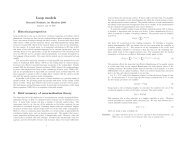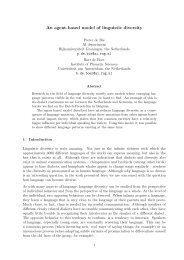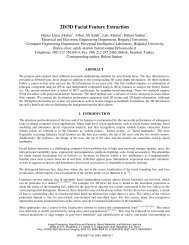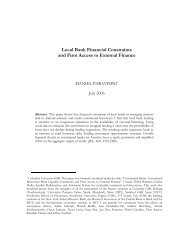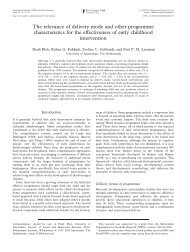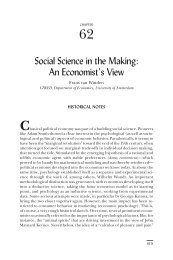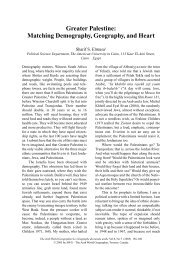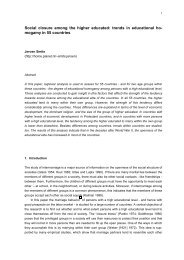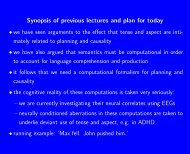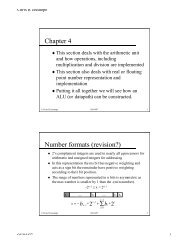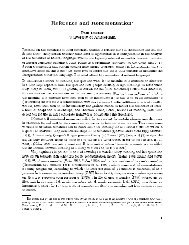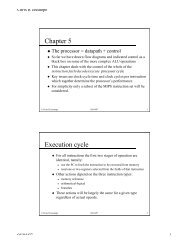Women's Scores on the Sexual Inhibition/Sexual Excitation Scales ...
Women's Scores on the Sexual Inhibition/Sexual Excitation Scales ...
Women's Scores on the Sexual Inhibition/Sexual Excitation Scales ...
Create successful ePaper yourself
Turn your PDF publications into a flip-book with our unique Google optimized e-Paper software.
WOMEN’S SIS=SES SCORES<br />
Table 2. C<strong>on</strong>firmatory Factor Analysis Results for Women<br />
and Men<br />
Group=Model v 2 df CFI SRMR NNFI RMSEA<br />
Women (N ¼ 966)<br />
Ten factor 2841.7 900 0.91 0.058 0.91 0.050<br />
Ten in three 3218.8 932 0.90 0.067 0.89 0.055<br />
Three factor 4373.1 942 0.85 0.073 0.84 0.073<br />
Men (N ¼ 922)<br />
Ten factor 2385.1 900 0.94 0.055 0.93 0.044<br />
Ten in three 2605.2 932 0.93 0.062 0.93 0.047<br />
Three factor 3287.8 942 0.90 0.066 0.90 0.057<br />
Note: v 2 ¼ Model chi square; CFI ¼ Bentler comparative fit index;<br />
SRMR ¼ Standardized Root Mean Square Residual; NNFI ¼ Tucker-<br />
Lewis N<strong>on</strong>-normed Fit Index; RMSEA ¼ Steiger-Lind Root Mean<br />
Square Error of Approximati<strong>on</strong> Index. (Better fit is reflected in higher<br />
coefficients [values approaching 1.0] for CFI and NNFI, and in smaller<br />
values [lower bound of zero] for SRMR and RMSEA.)<br />
<strong>the</strong>ir lifetimes (t (1902.04) ¼ 3.78, p ¼ .001). Finally, in<br />
comparis<strong>on</strong> with men, female participants reported<br />
more frequent difficulties with sexual arousal in <strong>the</strong> past<br />
3 m<strong>on</strong>ths (Z ¼ 7.57, p .001) and less frequent<br />
orgasms during sexual activity with a partner in <strong>the</strong> past<br />
year (Z ¼ 11.24, p .001).<br />
C<strong>on</strong>firmatory factor analysis results for<br />
women. CFA was utilized to test whe<strong>the</strong>r <strong>the</strong><br />
previously established three-factor model of men’s<br />
SIS=SES scores (Janssen et al., 2002a) dem<strong>on</strong>strated<br />
acceptable fit to a female dataset. This factor soluti<strong>on</strong><br />
was compared with two alternative models previously<br />
examined in males. These included a simple 45-item,<br />
10-factor model, and a ‘‘10-in-3’’ hierarchical model,<br />
featuring <strong>the</strong> same 45-item scores and 10 subscales<br />
loading <strong>on</strong>to three higher-level factors. After cases<br />
were eliminated due to missing data, <strong>the</strong> resp<strong>on</strong>ses of<br />
966 women and 922 men were retained. These analyses<br />
(with comparis<strong>on</strong> statistics for men) are presented in<br />
Table 2.<br />
The v 2 test of <strong>the</strong> null hypo<strong>the</strong>sis (which assumes<br />
complete model data c<strong>on</strong>sistency) had to be rejected<br />
for all models for both women and men (Janssen et al.,<br />
2002a). This finding was not unexpected, given <strong>the</strong> number<br />
of observati<strong>on</strong>s and <strong>the</strong> complexity of <strong>the</strong> specified<br />
models. Moreover, <strong>the</strong> v 2 is inflated because of <strong>the</strong> use<br />
of n<strong>on</strong>normal data (i.e., Likert scale items). Therefore,<br />
we also utilized alternative fit measures that are less<br />
sensitive to sample size, or that do not depend solely<br />
<strong>on</strong> <strong>the</strong> v 2 statistic. The Standardized Root Mean Square<br />
Residual (SRMR) is a functi<strong>on</strong> of <strong>the</strong> residuals. Hu and<br />
Bentler (1999) proposed that values below .08 are<br />
indicative of good model fit.<br />
Bentler’s Comparative Fit Index (CFI) and <strong>the</strong><br />
Bentler–B<strong>on</strong>nett N<strong>on</strong>-normed Fit Index (NNFI) are<br />
popular fit measures that compare <strong>the</strong> existing model<br />
with <strong>the</strong> independence model. Hu and Bentler (1999)<br />
proposed that an NNFI and a CFI above .95 is<br />
preferred (range ¼ 0–1; higher values mean better fit),<br />
although models with values of NNFI and CFI >.90<br />
often are seen as good fitting models. Finally, <strong>the</strong> Steiger-Lind<br />
Root Mean Square Error of Approximati<strong>on</strong><br />
(RMSEA) index is relatively insensitive to sample size<br />
and corrects for model complexity. Smaller values (with<br />
a lower bound of zero) indicate better fit. In general, an<br />
RMSEA of



